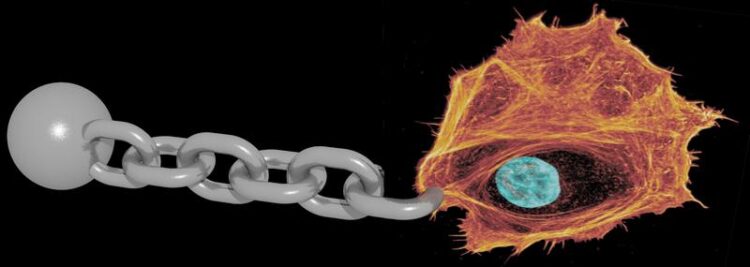Heavy water makes biological clocks tick more slowly

Fluoreszenzaufnahmen zeigten, dass sich Zellen nicht sichtbar morphologisch veränderten. Die Verlangsamung der Dynamiken beruht einzig auf der Anwesenheit von schwerem Wasser.
Foto: Universität Leipzig
How to Retard Time for Cells…
Scientists at Leipzig University, in collaboration with colleagues from Germany and England, have succeeded in reversibly slowing down cellular processes. A team of biophysicists led by Professor Josef Alfons Käs and Dr Jörg Schnauß were able to show in experiments that cells can be transferred into slow motion without changing the temperature. From a physical point of view, such possibilities have so far only been available in the context of the theory of relativity. They recently published their findings in the renowned journal “Advanced Materials”.
Cells are not only our biological building blocks, but also highly dynamic, active systems. The research group led by Professor Käs has succeeded in significantly reducing these dynamics with heavy water, without damaging the cells.
“Generally, a lot of people know heavy water for its important technical use in nuclear power plants. We took a different approach here and were able to show that for cells, time – or, more specifically, their dynamics – can be significantly slowed down in the presence of heavy water,” said Käs, who has devoted himself to researching the physical properties of cells and tissue. The research showed on various biological levels that the movement of cells and their dynamics was only taking place in slow motion.
“It is very intriguing that cellular dynamics can be slowed down at the same temperature. So far, only the theory of relativity has offered such possibilities in the physical context,” explained Käs. He added that the results form the basis of a method to offer cells and organs longer-lasting protection against degeneration.
The researchers confirmed this effect with a variety of complementary methods and attributed the observations to an increased interaction between the structural proteins. “Heavy water also forms hydrogen bonds, but these are stronger than in normal aqueous environments. As a result, structural proteins such as actin seem to interact more strongly with one another and briefly stick together. What is spectacular here is that the effects are reversible, with cells showing their native properties again as soon as they are transferred into a normal aqueous medium,” said Dr Jörg Schnauß. “What is even more astonishing is that these changes show the fingerprint of a passive material. However, cells are highly active and far from thermodynamic equilibrium. If they behave like a passive material, they are usually dead,” added Käs.
However, as the researchers were able to show, this was not the case in their experiments. They now hope to be able to use the knowledge gained to keep cells or even tissue vital for longer. If this approach is confirmed, heavy water could be used for longer storage times, for example during organ transplants.
Original title of the publication in Advanced Materials:
“Cells in Slow Motion: Apparent Undercooling Increases Glassy Behavior at Physiological Temperatures”,
DOI: doi.org/10.1002/adma.202101840
Wissenschaftliche Ansprechpartner:
Prof. Dr. Josef A. Käs
Peter-Debye-Institut für Physik der weichen Materie der Universität Leipzig
Telephone +49 341 97-32470
EMail: jkaes@physik.uni-leipzig.de
Dr. Jörg Schnauß
Peter-Debye-Institut für Physik der weichen Materie der Universität Leipzig
Telephone +49 34197-32753
EMail: joerg.schnauss@uni-leipzig.de
Weitere Informationen:
https://onlinelibrary.wiley.com/doi/full/10.1002/adma.202101840
Media Contact
All latest news from the category: Life Sciences and Chemistry
Articles and reports from the Life Sciences and chemistry area deal with applied and basic research into modern biology, chemistry and human medicine.
Valuable information can be found on a range of life sciences fields including bacteriology, biochemistry, bionics, bioinformatics, biophysics, biotechnology, genetics, geobotany, human biology, marine biology, microbiology, molecular biology, cellular biology, zoology, bioinorganic chemistry, microchemistry and environmental chemistry.
Newest articles

Innovative 3D printed scaffolds offer new hope for bone healing
Researchers at the Institute for Bioengineering of Catalonia have developed novel 3D printed PLA-CaP scaffolds that promote blood vessel formation, ensuring better healing and regeneration of bone tissue. Bone is…

The surprising role of gut infection in Alzheimer’s disease
ASU- and Banner Alzheimer’s Institute-led study implicates link between a common virus and the disease, which travels from the gut to the brain and may be a target for antiviral…

Molecular gardening: New enzymes discovered for protein modification pruning
How deubiquitinases USP53 and USP54 cleave long polyubiquitin chains and how the former is linked to liver disease in children. Deubiquitinases (DUBs) are enzymes used by cells to trim protein…



